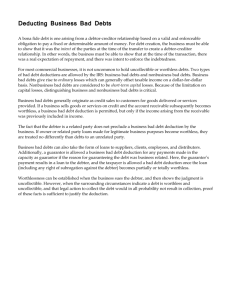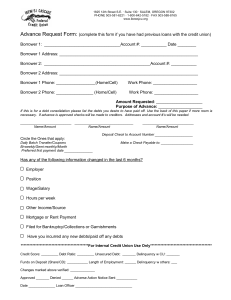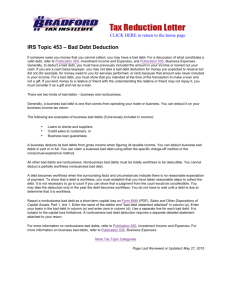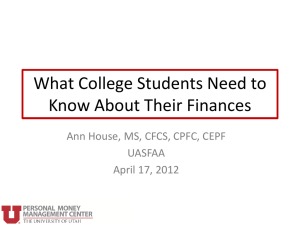Bad Debts 1 10 Basics Non Business
advertisement
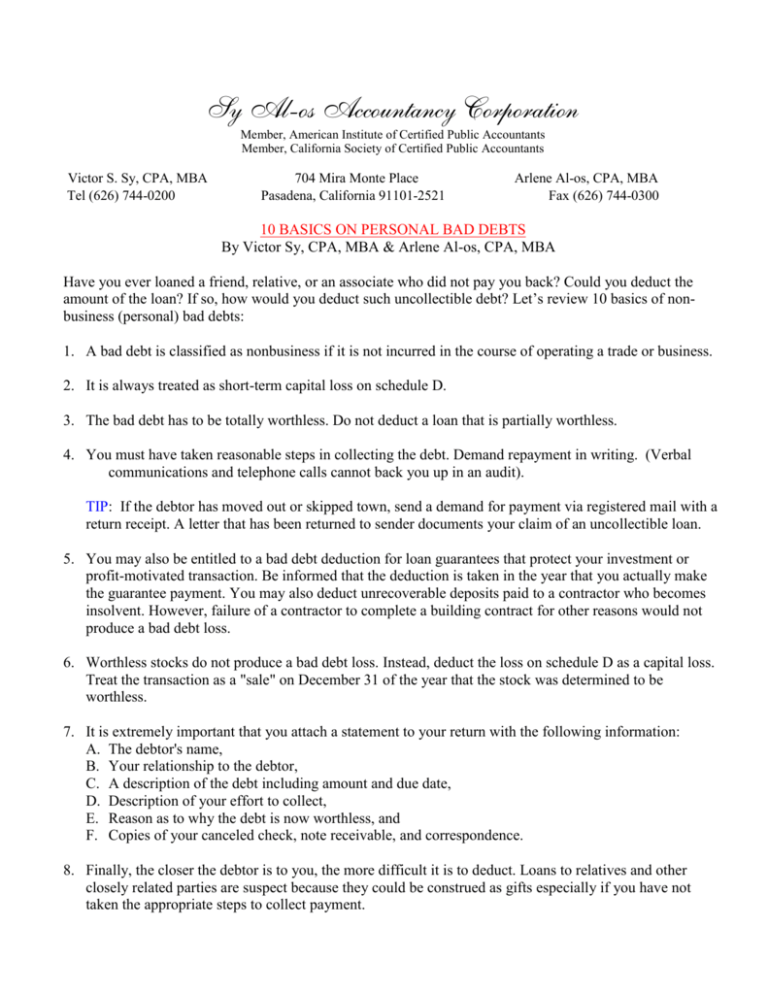
Sy Al-os Accountancy Corporation Member, American Institute of Certified Public Accountants Member, California Society of Certified Public Accountants Victor S. Sy, CPA, MBA Tel (626) 744-0200 704 Mira Monte Place Pasadena, California 91101-2521 Arlene Al-os, CPA, MBA Fax (626) 744-0300 10 BASICS ON PERSONAL BAD DEBTS By Victor Sy, CPA, MBA & Arlene Al-os, CPA, MBA Have you ever loaned a friend, relative, or an associate who did not pay you back? Could you deduct the amount of the loan? If so, how would you deduct such uncollectible debt? Let’s review 10 basics of nonbusiness (personal) bad debts: 1. A bad debt is classified as nonbusiness if it is not incurred in the course of operating a trade or business. 2. It is always treated as short-term capital loss on schedule D. 3. The bad debt has to be totally worthless. Do not deduct a loan that is partially worthless. 4. You must have taken reasonable steps in collecting the debt. Demand repayment in writing. (Verbal communications and telephone calls cannot back you up in an audit). TIP: If the debtor has moved out or skipped town, send a demand for payment via registered mail with a return receipt. A letter that has been returned to sender documents your claim of an uncollectible loan. 5. You may also be entitled to a bad debt deduction for loan guarantees that protect your investment or profit-motivated transaction. Be informed that the deduction is taken in the year that you actually make the guarantee payment. You may also deduct unrecoverable deposits paid to a contractor who becomes insolvent. However, failure of a contractor to complete a building contract for other reasons would not produce a bad debt loss. 6. Worthless stocks do not produce a bad debt loss. Instead, deduct the loss on schedule D as a capital loss. Treat the transaction as a "sale" on December 31 of the year that the stock was determined to be worthless. 7. It is extremely important that you attach a statement to your return with the following information: A. The debtor's name, B. Your relationship to the debtor, C. A description of the debt including amount and due date, D. Description of your effort to collect, E. Reason as to why the debt is now worthless, and F. Copies of your canceled check, note receivable, and correspondence. 8. Finally, the closer the debtor is to you, the more difficult it is to deduct. Loans to relatives and other closely related parties are suspect because they could be construed as gifts especially if you have not taken the appropriate steps to collect payment. 9. Here are some factors that helped taxpayers win in Tax Court: A promissory note was signed by the borrower and delivered by the lender, the money borrowed was secured, the note provided for the payment of interest, and the borrower was solvent when the money was lent. In a Tax Court case (Bowman vs. Commissioner), the taxpayer made mostly undocumented loans totaling $35,000 to his 23-year old daughter who used the funds to open and operate a skating rink business. The only formal loan arrangement was a note co-signed by the father to a third party lender. The other $32,000 was documented only by the daughter's deposit slips, canceled personal checks that included the notation “loan.” The skating rink failed and the business shut down. The father claimed a $35,000-nonbusiness bad debt. No collection efforts were undertaken against the daughter who then filed for bankruptcy the following year. As expected, the IRS argued that the advances were gifts, not bonafide loans. The Tax Court sided with the taxpayer. The father was saved by the “loan” notations on the check and the fact that he had made eight additional loans to other family members and friends over the years. All loans were either repaid or were in the process of being repaid at the time of the trial. The Tax Court observed that legal action is not a prerequisite to concluding that the debt is uncollectible. If the circumstances indicate that a debt is worthless and that a legal action will probably not result in any payment, a debt deduction can still be allowed. 10. Here are some factors that caused taxpayers to lose in Tax Court: No provision for interest was made, no method or time for repayment was stipulated, there was no intention to enforce collection, the borrower could not have borrowed from anyone else, the obligation to repay was contingent on events, the lender knew that the borrower could not repay but merely hoped anyway. Memo: These tips refer to personal bad debts. Business bad debts are handled differently. Such debts are deducted as business expenses for accrual-basis companies. Cash-basis companies are not able to deduct bad debts because these were not reported as income in the first place.

